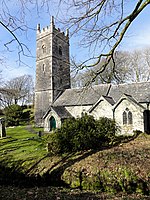The Museum of Witchcraft and Magic, formerly known as the Museum of Witchcraft, is a museum dedicated to European witchcraft and magic located in the village of Boscastle in Cornwall, south-west England. It houses exhibits devoted to folk magic, ceremonial magic, Freemasonry, and Wicca, with its collection of such objects having been described as the largest in the world.
The museum was founded by the English folk magician Cecil Williamson in 1951 to display his own personal collection of artefacts. Initially known as the Folklore Centre of Superstition and Witchcraft, it was located in the town of Castletown on the Isle of Man. Williamson was assisted at the museum by the prominent Wiccan Gerald Gardner, who remained there as "resident witch". After their friendship deteriorated, Gardner purchased it from Williamson in 1954, renaming it the Museum of Magic and Witchcraft. Gardner's Castletown museum remained open until the 1970s, when Gardner's heir Monique Wilson sold its contents to the Ripley's company.
In 1954, Williamson opened his own rival back in England, known as the Museum of Witchcraft. Its first location was at Windsor, Berkshire, and the next at Bourton-on-the-Water, Gloucestershire; in both cases it faced violent opposition and Williamson felt it necessary to move, establishing the museum in Boscastle in 1960. In 1996 Williamson sold the museum to Graham King, who incorporated the Richel collection of magical regalia from the Netherlands in 2000. The museum was damaged and part of its collection lost during the Boscastle flood of 2004. In 2013 ownership was transferred to Simon Costin and his Museum of British Folklore.
The museum is a popular tourist attraction and is held in high esteem by the British occult community. A charity, Friends of the Museum of Witchcraft, has been established to raise funds for the exhibits. The museum also contains a large library on related topics that is accessible to researchers.












